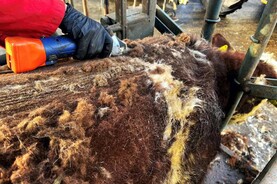As well as being a condition of early lactation, when cows are housed or occurring in mucky ground conditions at pasture, E coli can also occur as calving approaches.
This is a type of mastitis often called acute coliform mastitis and is an emergency.
Cause
The E.coli bug will be picked up in the dry period or when a cow starts milking. It most often occurs in environments with poor hygiene standards. It can often affect cows that have other underlying complaints, such as milk fever, ketosis or some other immunosuppression. But it can also affect healthy cows.
Symptoms
The main clinical signs are severe depression, shock, temperature and the affected quarter will have a watery discharge. Treatment success depends on how early you detect and treat the mastitis. It is the endotoxins that the bug releases when they die which cause the severity of the condition. Tubing these cases will have very limited success, and on its own may exacerbate the problem as further toxins will be released by the dead bacteria.
Treatment
Cases should be treated aggressively with I/V fluids, oral fluids, anti-inflamatories and a covering antibiotic. The important thing is this endotoxic shock is reversed quickly and that the affected quarter is stripped out vigorously and regularly. It is important if stripping out the quarter that the discharge is removed and not done in the calving area.
If left, cows will often deteriorate and go down. In a freshly calved cow, one would classify true coliform mastitis as a medical emergency.
Prevention
It can happen sporadically, but if it occurs in more than 2% of the herd, dry cow management and environmental hygiene should be assessed on farm. Most of these E coli are found in manure so the hygiene in the environment and at milking is of the utmost importance.
Freshly calved cows should be checked regularly for teat hygiene. Disinfection greatly aids in reducing the risk. Make sure calving boxes are cleaned regularly; avoid the build-up of slurry indoors; and make sure the cubicles are cleaned (twice daily)and limed frequently (at least daily). There should be at least one cubicle per cow, but ideally 1.1 cubicles per cow.
Ensure that the cluster is put on to clean dry teats. Ensure cows stand for 30 minutes after milking, to make sure the teat sphincter is closed when they go to lie down. This is classed as an environmental mastitis and farmers must try maintain hygiene in both housed lactating and dry dairy cows to the best standards.






 This is a subscriber-only article
This is a subscriber-only article










SHARING OPTIONS: